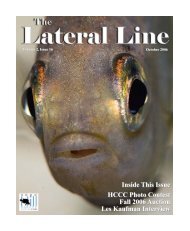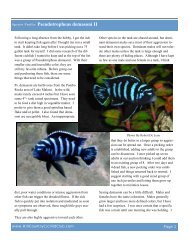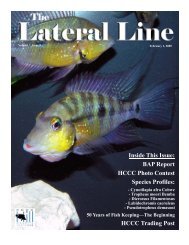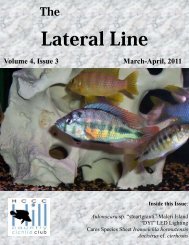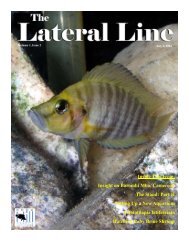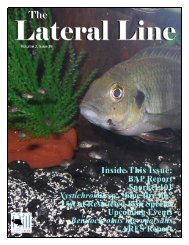December - Hill Country Cichlid Club
December - Hill Country Cichlid Club
December - Hill Country Cichlid Club
Create successful ePaper yourself
Turn your PDF publications into a flip-book with our unique Google optimized e-Paper software.
16<br />
at all. I enjoyed watching them slowly develop.<br />
After a year, one of the individuals began transforming<br />
from silver to a light gray. Over a few<br />
months the coloration became a darker and darker<br />
gray until eventually the body was light black. The<br />
speckling became a bit more prominent during this<br />
time frame as well. There were still no signs of real<br />
aggression but this developing male had one side of<br />
the tank to himself and the other two tended to keep<br />
to the other side. All three would move freely without<br />
any aggression issues, but the tendency of the<br />
group was to stay on their own sides. The male was<br />
really coming into his own in regards to his coloration<br />
and was now in full bloom. This did not translate<br />
into any courting behavior though. Several<br />
months went by and the other two fish were starting<br />
to spar somewhat. As time drew on, a full out battle<br />
between the two females ensued. The two females<br />
spent several weeks rushing at each other and jaw<br />
locking. I was observing this closely as I could not<br />
afford to lose any of the fish. Despite the battle<br />
royal no visible damage was being done to either<br />
fish. Eventually this activity subsided and one of<br />
the females was now hanging out with the male in<br />
his rock pile. By no means were they exhibiting<br />
pairing behavior, but were definitely getting along<br />
enough to allow each other in the same area. The<br />
other fish stayed in her half of the tank. I have not<br />
seen any fighting between those two since that one<br />
frenzied period. The male was now in breeding coloration<br />
at all times and could be seen displaying to<br />
the female often. He would sashay across the tank<br />
and court the other female as well. This went on for<br />
several weeks before I actually witnessed a female<br />
with buccal cavity full of eggs. Over several<br />
months I had a female holding three times and never<br />
more than a week. The next time it happened I decided<br />
I would strip the eggs and tumble them. Unfortunately<br />
there has not been a next time. While<br />
the male has maintained his vibrant hues and occasionally<br />
shimmies up to a female, there has been<br />
almost zero courting behavior.<br />
More time passes I determine it is time to start tinkering<br />
with some water parameters to see if I can<br />
trigger a spawning. The nervousness I exhibited a<br />
couple of years ago is now gone and I am not too<br />
concerned about playing mad scientist. Many fish<br />
will spawn during a rainy season because they have<br />
learned that along with the rain come enhanced food<br />
sources. The first thing I do is to slowly lower the<br />
salt content in the tank. Once lowered, I would<br />
maintain it for at least a month. By the time I have<br />
tweaked it down as far as I felt comfortable with;<br />
the salt levels were about 25% of the original quantity.<br />
This wasn’t working. Next I varied the diet<br />
and begin feeding mosquito larvae I was collecting<br />
in a bucket outside. I also increased the frequency<br />
of the protein flake. With little effect, I tried a different<br />
brand of food, again, with no luck. The next<br />
factor to alter was temperature. I began by lowering<br />
the temperature of the heater and eventually turned<br />
it off. The lowest temperature the water reached<br />
was about 18C. I also proceeded to alter the salt<br />
content again as I was experimenting with the temperature.<br />
Once this failed to trigger any responses I<br />
began to crank the temperature up and had the<br />
heater up to 31C before deciding not to go any<br />
higher. I will admit while I was frustrated it was an<br />
enjoyable challenge as well. These fish were making<br />
me work to entice a spawning and I was having<br />
fun trying to outsmart them. After many months of<br />
this I still had nothing as far as spawns, but still had<br />
3 healthy fish that appeared no worse for wear.<br />
I reached out to a friend who wasn’t having any<br />
luck and he was able to pass along 4 females from<br />
his group all in the name of getting this species to<br />
breed. While there has been increased courting behavior<br />
only one spawn has been witnessed and it



